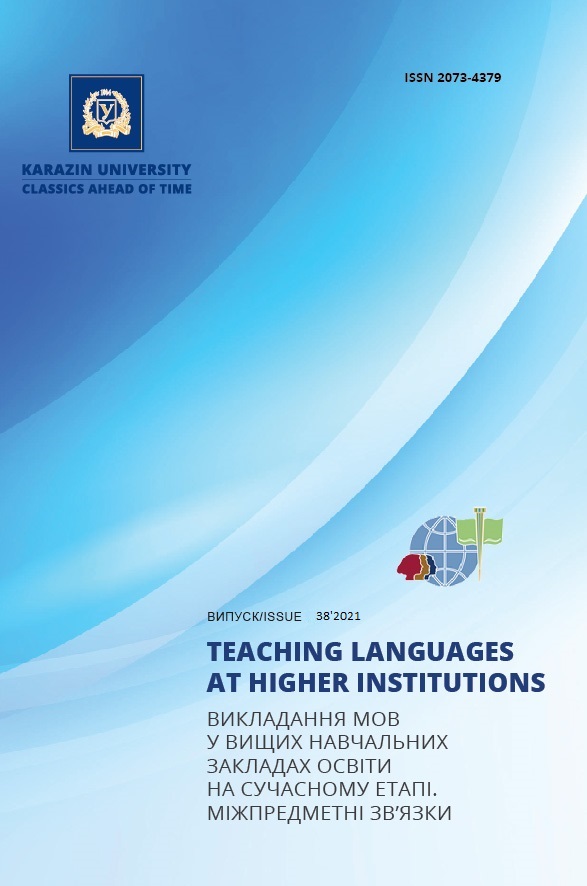Проблеми функціонування сучасних арабських антропонімів в умовах міжкультурної комунікації українського освітнього простору
Анотація
У статті розглянуто проблеми функціонування сучасних арабських антропонімів в умовах міжкультурної комунікації на прикладі власних імен освітніх мігрантів Харківського національного університету імені В.Н. Каразіна, що складають значну кількість (до 40%) усіх іноземних студентів даного закладу вищої освіти. Проблеми, що досліджуються, пов’язані як із лінгвокомунікативними компетентностями адресантів (викладачів, мовників та предметників, співробітників деканатів), так і з лінгвосоціокультурними компетентностями адресатів (іноземних студентів, магістрантів, аспірантів) і стосуються комунікативного дискомфорту на рівні викладач або співробітник деканату – арабський освітній мігрант. За об’єкт дослідження обрано порівняння структури інваріантів антропонімічних формул різних арабських країн та їхнього функціонування в умовах українського діловодства та в навчальному дискурсі українського освітнього простору. Актуальність даної наукової розвідки підтверджена фактами великої кількості арабських країн, в яких функціонують численні діалекти з антропонімічними формулами, що мають індивідуальний склад та порядок слідування складників. У статті реалізована мета описання розбіжностей української та інваріантів арабської антропонімічної формули, націлення викладачів на формування в інофонів свідомого ставлення до інваріантів власного імені та їхніх функцій в освітньому просторі України, виділено й означено три таких основних формули, наведено приклади вправ на усвідомлення складу таких формул та на розуміння комунікативних завдань, які вирішуються за допомогою кожної з них. У статті представлений порівняльний аналіз антропонімічної формули у паспорті арабських студентів різних країн, складників формули власного імені в українській Єдиній державній електронній базі з питань освіти та в посвідці освітнього мігранта на тимчасове проживання в Україні. Названо проблеми, які зумовлені функціонуванням цих трьох інваріантів під час занять з української мови як іноземної, показано зумовлені цими інваріантами труднощі лінгвокомунікативної самоідентифікації освітнього мігранта в іншомовному соціумі та формування його вторинної мовної особистості.
Завантаження
Посилання
Belei, L. (2016). Priroda osobovyh imen ta yih vidtvorennia zasobami chuzhoi movy [Nature of personal names and their reproduction by means of a foreign language]. Suchsni problemy movoznavstva i literaturoznavstva [Modern problems of linguistics and literary criticism]. Uzhgorod, 21, pp. 198–202 [in Ukranian].
Burik, K. (2011). Stanovlennia, csuchasnyy sklad ta areal arabskogo antroponikonu [Formation, present day composition and areal of Arabic antroponimicon]. Visnic Lviv universitet [Bulletin of Lviv University]. Ser. philological. Lviv, 54, pp. 15–22 [in Ukranian].
Vrublevskaya, O.V. (2017). Transformastiia russkoi antroponimicheskoi formuly kak proiavlenie modnogo rechevogo povedeniia. Iazykovaia moda v russkoi onomastike [Transformation of the Russian antroponomic formula as a manifestation of fashion speech behavior. Language fashion in Russian onomastics]. Doctor’s thesis. Volgograd, pp. 315–326. Availiable at: https://vspu.ru/sites/default/files/disfiles/dissertations/ dissertaciya_vrubleskoy_o.v..pdf [Accessed 24 March, 2021] [in Russian].
Dospanova, D.U. (2017). Antroponimy i nekotorue aspektu ih izucheniia [Antroponyms and some aspects of their study]. Molodoi uchenyi [Young scientist], 14, pp. 712–714 [in Russian].
Ilizarova, A.C., Starostin, A.O. and Heiry, O. (1970). O vnutrennei forme i proishozhdenii arabskih imen. Lichnye imena v proshlom, nastoyaschem i buduschem [About internal form and origin of Arabic names. Personal names in the past, present and future]. Moscow, pp. 290–300 [in Russian].
Kovyrshina, N.B. (2001). Imena sobstvennue v culture arabov [Proper nouns in the Arabic culture]. Vestnik RUDN [Bulletin of the RUDN University]. Ser. Literary criticism, journalism, 5, pp. 63–66 [in Russian].
Kuplevastka, L.O. and Manivska, T.E. (2016). Osoblivosti lingvakulturnoy adaptastii indiyskih studentov u vyschuh navchalnuh zakladah Ukrainy v kontekste mizhkulturnoy komunikastii [Peculiarities of linguacultural adaptation of Indian students at higher school of Ukraine in the context of intercultural communication]. Vykladannia mov u vyshchykh navchalnykh zakladakh osvity na suchasnomu etapi. Mizhpredmetni zviazky [Teaching Languages at Higher Institutions]. Kharkiv: V.N. Karazin Kharkiv National University, 29, pp. 55–69 [in Ukrainian].
Kuplevastka, L.O. (2019). Profesiyna lingvakomunikativna kompetentnist vykladacha v konteksti mizhkulturnoi komunikastii [A teacher’s professional linguacommunicative competence in the context of intercultural communication]. Vykladannia mov u vyshchykh navchalnykh zakladakh osvity na suchasnomu etapi. Mizhpredmetni zviazky [Teaching Languages at Higher Institutions]. Kharkiv: V.N. Karazin Kharkiv National University, 34, pp. 79–92 [in Ukrainian]. DOI: https://doi.org/10.26565/2073-4379-2019-34-06.
Kuplevastka, L.O. (2019). Skladnyky imidzhu vykladacha vyschoi shkoly v konteksti mizhkulturnoi komunikastii [Parts of teacher’s image in the context on intercultural communication]. Mizhculturna komunicastiia v universitetskomu osvitnomu prostori [Intercultural communication in the unified vrrsatility]. Kharkiv, pp. 193–208 [in Ukrainian].
Kuplevastka, L.O. and Manivska, T.E. (2020). Lingvkomunikatyvna kompetentnost vykladacha-movnika: etnospetsyfika funcstionuvannia antriponimiv u navchalno-pedagogichnimu diskursi universytetskogo prostoru [Linguocommunicative competence of the language teacher: ethnospecificity of anthtoponyms functioning in the learning and pedagogical discourse of the educational space]. Vykladannia mov u vyshchykh navchalnykh zakladakh osvity na suchasnomu etapi. Mizhpredmetni zviazky [Teaching Languages at Higher Institutions]. Kharkiv: V.N. Karazin Kharkiv National University, 36, pp. 111–130 [in Ukrainian]. DOI: https://doi.org/10.26565/2073-4379-2020-36-09.
Liga Arabskih derzhav [Ligue of Arabic countries]. Availiable at: https://mfa.gov.ua/mizhnarodni-vidnosini/liga-arabskih-derzhav [Accessed 2 March 2021] [in Russian].
Madieva, G.B. and Suprun, V.I. Antroponimy kak sredstvo vyrazheniia natsionalnoy kultury [Antroponyms as means of expression of national culture]. Availiable at: https://cyberleninka.ru/journal/n/izvestiya-volgogradskogo-gosudarstvennogo-pedagogicheskogo-universiteta. [Accessed 2 March 2021] [in Russian].
Polnyy spisok arabskih stran [The full list of Arabic countries]. Availiable at: https://arabicsky.ru/news-post/polnyj-spisok-araboyazychnyx-stran-2017/ [Accessed 25 March 2021] [in Russian].
Raznovidnosti arabskogo iazyka [Varieties of the Arabic language]. Availiable at: https://ru.wikipedia.org/wiki/ [Accessed 2 March 2021] [in Russian].
Reformatskiy A.A. (1972). Perevod ili transcriptsiia. Vostochoslavianskaia onomastika [Translation or transcription. Eastern Slavonic onomastics]. Moskow: Nauka, pp. 328–340 [in Russian].
Tak skolko zhe narodov govoriat na arabskom iazyke? [How many people speak the Arabic language?]. Availiable at: http://www.pereklady.kiev.ua/ru/arabik/ [Accessed 2 March 2021] [in Russian].
Zhang Yu, Ian Huei and Soloviova, M. Nastionalno-kulturnaia semantika russkih i kitaiskih antroponimo [National cultural semantics of Russian and Chinese antroponymes]. Availiable at: https://cyberleninka.ru/article/n/natsionalno-kulturnaya-semantika-russkih-i-kitayskih-antroponimov [Accessed 2 March 2021].

